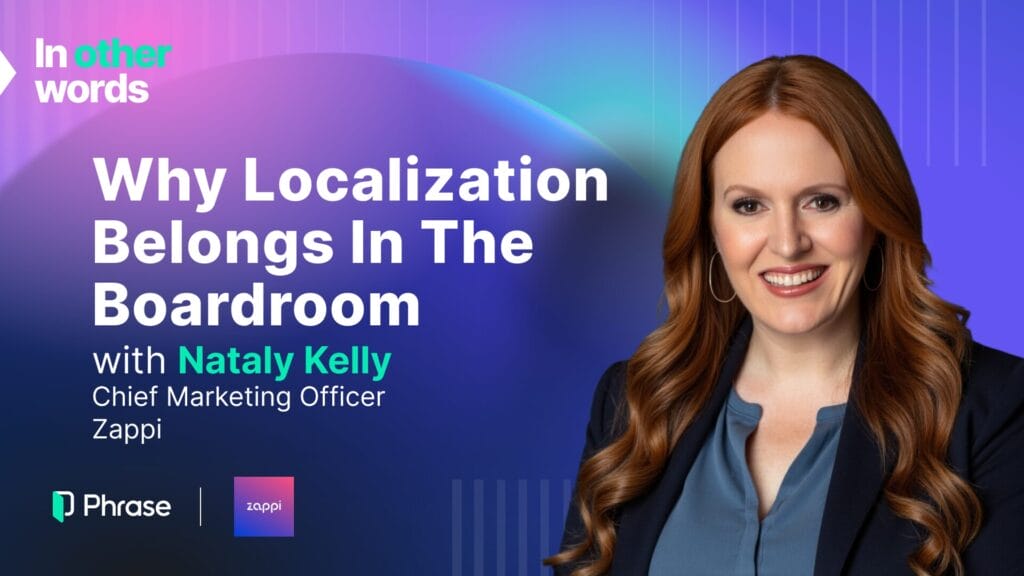1. Introduction: AI’s role in the retail revolution
Faced with rising customer expectations, thinner margins, and pressure to expand internationally, retailers are doubling down on AI to drive efficiency and scale. From personalized recommendations to automated inventory, AI has moved far beyond the experimental stage, and is now embedded at an operational level.
But there is a problem: most retailers are treating AI as a tool for speed and automation, when they should be using it to create relevance. And that’s where growth efforts start to stall.
The brands gaining ground today have moved beyond just looking at increasing speed, and are instead using technology to move more intelligently across markets, delivering experiences that feel tailored to each customer, in every region.
Customers now expect seamless, relevant experiences across every channel and in every language. That means retailers need to offer hyper-personalization at scale, while keeping their brand tone consistent and their messaging culturally relevant.
And thanks to recent advances in generative AI and machine learning, retailers can now localize at scale across their operations, without sacrificing quality, brand voice, or speed.

Findings from a global survey of 2,000 business leaders conducted by Censuswide for Phrase found that almost three quarters (73%) of business leaders globally believe in the potential of AI and LLMs and are excited by the prospect of AI to drive business expansion, and this is because AI can now enable localization at scale.
With tools designed to handle multilingual automation, retailers can scale their content globally without losing the nuance that makes it resonate locally. Whether it’s a product description, a customer support response, or a promotional email, AI can help ensure each message lands with the right tone, intent and impact.
At the same time, AI supports omnichannel brand consistency, helping teams maintain a unified voice across websites, apps, emails, social posts and more. This can improve the customer experience, as well as building trust with customers.
The global market for AI in retail is projected to reach $31 billion by 2028, indicating rapid adoption and investment in AI solutions within the industry. (source)
AI is becoming a core part of how modern retailers grow, and for brands looking to compete globally, AI-powered localization is no longer optional. It’s a genuine competitive advantage.
In this guide, we’ll explore how AI can help retailers overcome common localization challenges and unlock the full potential of global growth, without sacrificing quality, voice, or trust.
2. The human side of smart retail: AI that respects context and culture
As retailers increasingly adopt AI to drive efficiency, personalization, and growth, a common concern is that automation risks losing the emotional nuance and empathy that human interactions provide.
From chatbots that can’t read customer frustration to algorithm-driven recommendations that miss cultural context, critics argue that AI lacks the intuition needed to build genuine customer connections. In a world where brand loyalty is tied closely to trust and experience, this perceived coldness can become a real barrier.
But the counterpoint is equally strong: when used well, AI doesn’t replace the human touch, it amplifies it. AI can free up teams to focus on higher-value, relationship-driven tasks, and deliver personalization at scale that would be impossible manually.
AI is changing how brands engage with customers at scale, from real-time support to personalized content delivery. In customer service, AI handles routine queries instantly while escalating complex or emotional cases to trained agents.
But delivering consistent experiences across markets takes more than fast responses. It requires clear, culturally relevant communication across languages and channels. That’s where AI-powered content and localization play a critical role, enabling tone-aware translations and tailored messaging that keep every interaction on-brand and meaningful.
That’s why the most effective AI strategies in retail combine automation with human expertiseI. With the right tools (like Phrase Quality Performance Score) and intelligent routing, retailers are are scaling content quality without compromising nuance. AI handles the high-volume checks and repetitive reviews while human reviewers focus on messaging that needs creative judgment, emotional sensitivity or brand precision.
The key isn’t choosing between AI and human input. It’s designing systems where both work together to create smarter, more meaningful retail experiences.
3. AI-driven retail trends
From streamlining internal workflows to delivering better customer experiences, AI tools are helping retail brands work smarter and scale faster. And for retailers with global ambitions, it’s opening the door to new ways of connecting with customers in more meaningful, efficient, and consistent ways.
89% of retail and CPG (consumer packaged goods) respondents to an Nvidia survey said that they’re either using AI in their operations or assessing AI projects in trials and pilots. (source)
AI-first retail strategies
Retailers are increasingly taking an ‘AI-first’ approach, using technology not just to automate processes, but to enhance the customer experience.
AI now powers everything from real-time product recommendations to dynamic content creation. One example is Zara, which uses automation to personalize the shopping experience, as well as adapting product recommendations to suit local trends. (Source)
The latter example of AI-powered localization is a key trend. Instead of relying on static content, retailers can now deliver messaging that’s adapted in real time to suit the language, tone, and culture of each market.
This is the foundation for hyper-personalization at scale. It’s about creating tailored experiences for customers across different regions, without needing to manually recreate everything from scratch.
A global survey of 2,000 business leaders by Censuswide for Phrase found that 61% of businesses globally are not currently using AI to deliver a personalized approach through every customer touchpoint. This presents an opportunity for retailers to gain an advantage over competitors.
Whether it’s fine-tuning a call-to-action or updating promotional content for a local event, AI makes it easier to be relevant in multiple markets and languages at once.
AI-enhanced omnichannel retail
Customers don’t think in channels, they move fluidly between a retailer’s website, social feed, mobile app, and physical store. That makes omnichannel brand consistency a priority. AI helps ensure that messaging, tone, and product information stay aligned across every touchpoint.
AI-powered omnichannel marketing is the key to delivering personalization at scale. By unifying and analyzing customer and product data, AI helps marketers personalize and optimize the entire customer journey across multiple channels. It also enables smarter campaign decisions and predicts which channels will be most effective.
It also helps teams work more efficiently behind the scenes. For example, AI can automatically update product data across platforms or suggest localization tweaks to keep content on-brand and culturally appropriate.
AI for ethical and sustainable retail
With growing demand for transparency, ethical AI and content authenticity are becoming essential. Customers want to know where products come from, how they’re made, and whether a brand’s values align with their own. AI can help retailers deliver on this by automating supply chain tracking, surfacing sustainability credentials, and adapting messaging to reflect local compliance requirements.
AI can also help retailers to become more sustainable by reducing waste and improving resource efficiency across inventory management and logistics.
For example, Kaufland, the group behind LIDL, uses AI to forecast demand and optimize stock levels, preventing excess perishables from going to waste. (source) In fashion, retailers like Aldo use AI to align inventory with real-time customer demand, reducing overproduction and unsold stock. (source)
On the logistics side, AI enhances delivery routes and supply chain integration, cutting fuel use and emissions. Altogether, these AI-driven efficiencies conserve energy, water, and materials, making retail operations leaner and greener.
Making LLMs work for scalable, brand-consistent multilingual content
4. How AI-powered localization transforms global retail
Expanding into new markets used to be a slow, resource-heavy process. For many retailers, localization meant months of manual translation, multiple rounds of editing, and endless back-and-forth to ensure cultural relevance and compliance.
AI-powered localization now fast-tracks these processes, allowing a greater agility which makes it easier to scale content and personalize experiences.
Multilingual content at scale
The sheer volume of content retailers need to manage, from product pages and customer support responses to marketing emails and app notifications, makes manual localization unscalable. Multilingual automation solves this by translating and adapting content instantly, using context-aware AI models that go beyond literal word-for-word conversion.
Multilingual automation is the strategic orchestration of AI-powered translation, automation-driven workflows, and human review to deliver high‑quality, culturally-relevant content across multiple languages at speed and scale. Designed to integrate with existing content platforms and TMS tools, it automates extraction, translation initiation, quality assurance, and reintegration, freeing teams to focus on strategic localization decisions.
That means you can update a product description in 10 languages at once, or roll out a campaign across regions without starting from scratch each time. Better still, AI tools learn from previous outputs, so brand voice and tone remain consistent across every market.
Hyper-personalization across cultures
Today’s shoppers expect personalized experiences, but personalization isn’t one-size-fits-all. Preferences vary by region, culture, and even device. With the help of AI, retailers can deliver hyper-personalization at scale by tailoring everything from product recommendations and promotions to layout and copy based on local expectations.
For example, AI can learn that shoppers in one market respond better to loyalty discounts, while another prefers limited-time bundles. It can also adapt user interfaces to suit cultural norms. These are subtle changes that can make a big difference to engagement and conversion rates.
Real-time adaptation to market conditions
Economic shifts, seasonal trends, and local regulations can all impact what your messaging needs to say, and when you need to say it. AI helps retailers respond in real time, adjusting pricing, promotions, and product visibility based on live market data.
If you need to change a product’s messaging in response to new local legislation for example, AI can flag potential issues and suggest compliant alternatives. This agility is crucial in uncertain times, and helps brands stay responsive without sacrificing consistency.
AI for omnichannel consistency
One of the biggest challenges in global retail is keeping content aligned across channels. Customers expect a seamless experience whatever channel they use, and the order they use them in.
AI ensures omnichannel brand consistency by applying the same localization logic across platforms, keeping copy, tone, and information aligned. It also helps eliminate duplicated effort by syncing updates and streamlining review workflows.
We’re reaching a point where AI-powered localization doesn’t just make global retail possible, it becomes essential as it makes it practical, scalable, and more effective than ever. For retailers looking to expand, AI provides a key competitive advantage,
5. AI as the retail growth engine
For retailers looking to grow across borders, AI-powered localization isn’t just a time-saver, it’s a driver of growth. By automating the way content is translated, adapted, and delivered, AI helps brands move faster, speak more effectively to local audiences, and operate at a much larger scale.
AI is now directly impacting retail growth. According to Nvidia, 87% of retail and CPG brands said that AI has had a positive impact on their annual revenue. (source)
Here’s how AI supports growth on multiple fronts:
- Stronger customer engagement. AI-generated multilingual content captures local tone and context, helping brands to connect on an emotional level with audiences across different cultures.
- Higher conversion rates. AI can personalize content based on local behaviours and preferences, making adjustments in areas such as product recommendations and pricing. This means customers are more likely to see offers and experiences that feel relevant to them.
- Faster global expansion. Retailers can use AI to adapt content and messaging for new markets almost instantly. It also helps ensure local compliance and cultural sensitivity, so brands can launch confidently and quickly.
- Better discoverability. AI-powered localization supports multilingual SEO, so your content can become visible in local search results.
- Cost efficiency and scale. Manual localization takes time, resources, and budget. AI handles the bulk of the work automatically, allowing teams to focus on strategy and creativity while reducing overall costs.
Maximizing global ecommerce sales: How language creates a strategic advantage
How retail brands are leveraging AI technologies
With many retailers adopting AI, there are a range of valuable use cases for AI, from supply chain management to improving the customer experience.
Zalando: hyper-personalized experiences
Zalando uses AI to deliver hyper-personalized experiences, such as outfit suggestions and size advice, to enhance the customer journey and drive sales. Backed by a team of 120 researchers, the company invests heavily in technology to better understand both customer preferences and fashion trends.
The introduction of Zalando’s Algorithmic Fashion Companion (AFC) led to an increase in average basket sizes by 40%, and contributed to improved revenue. (source)
ASOS: AI-based Customer Lifetime Value
ASOS has implemented an AI-based Customer Lifetime Value (CLTV) prediction system that provides daily estimates of the future value of each customer. This system enables the company to effectively allocate marketing resources, identify and nurture high-value customers, and mitigate potential losses.
Through this use of automatically learned features, ASOS’s model has achieved a significant improvement over traditional handcrafted feature approaches. (source)
H&M: AI-powered chatbots
H&M uses AI-powered chatbots across its website, app, and social media to streamline customer service and enhance the shopping experience. These chatbots handle a range of tasks, from answering common queries and managing returns to offering personalized outfit recommendations and multilingual support. They also provide proactive stock updates and abandoned cart messaging, helping to drive engagement and conversions.
The benefits of this approach include 24/7 availability, faster response times, and improved scalability during peak shopping periods. While H&M hasn’t shared specific ROI figures, industry data shows that 95% of companies using AI report higher customer satisfaction, and 90% see gains in efficiency—suggesting strong performance and value from H&M’s chatbot strategy.
Trenýrkárna.cz’s expansion

Trenýrkárna.cz, an online men’s underwear retailer from the Czech Republic, leveraged Phrase’s AI-powered localization platform to accelerate its international expansion. By transitioning from external translation agencies to in-house management using Phrase’s machine translation technology, the company achieved:
- Reduced expansion costs by 85%, lowering per-market expenses from approximately €30,000 to a fraction of that amount
- Decreased translation turnaround time from two weeks to one day, enabling a 93% reduction in time-to-market.
- Expanded from three to 23 countries within two years, a process that would have otherwise taken nearly five years.
Additionally, Trenýrkárna.cz maintained high customer satisfaction in new markets, achieving a 4.8 out of 5-star rating on review platforms. The integration of Phrase allowed the company to manage translations efficiently with a lean team, freeing resources for strategic initiatives and further solidifying its position in the European market. (source)
Lyst’s collaborative localization strategy
Lyst, the world’s largest fashion search platform, used Phrase’s AI-powered localization platform to streamline global expansion and boost operational efficiency. By replacing fragmented workflows with a centralized system, Lyst enabled seamless collaboration across engineering, localization, and regional content teams.
The impact was significant: content could go live within one minute of translation, saving an average of 48 engineering hours per feature rollout. Lyst also expanded into 14 markets and launched content in eight languages almost instantly, allowing the team to focus on delivering high-quality user experiences across regions while scaling rapidly. (source)
Scaling localization with AI: How a fashion retailer cut turnaround times
An international fashion retailer turned to Phrase’sto transform its localization process and better manage high volumes of content across multiple markets. Faced with translating up to one million words per week and rising costs from outsourcing, the brand needed a scalable, high-quality solution to support growth and maintain consistency.
By integrating Phrase Custom AI and the Phrase NextMT machine translation engine, the company saw immediate results:
- 50% faster turnaround times, significantly accelerating time to market
- Improved translation quality, reducing the need for manual post-editing
- Greater in-house control, allowing teams to manage peak volumes without relying on external providers
- Higher translator engagement, thanks to tailored AI output that aligned with brand tone and context
The shift to AI-powered localisation enabled the brand to scale efficiently while maintaining high standards across all global markets. (source)
6. Future outlook: AI as the growth engine for retailers
McKinsey estimates that generative AI could unlock up to $390 billion in value for retailers, potentially increasing industry margins by 1.2 to 1.9 percentage points. (source)
AI isn’t replacing the human side of retail,it’s enhancing it. By automating the heavy lifting, AI gives teams more time to focus on what matters: building trust, improving customer experiences, and connecting with customers in ways that feel authentic and personal.
This is the real benefit of AI-powered localization. It isn’t just about speeding things up, it enables hyper-personalization at scale, helping retailers deliver locally relevant content across every touchpoint, in every language, and at every stage of the customer journey.
As the retail landscape becomes more competitive, those that embrace AI have an advantage. AI makes global expansion more achievable by breaking down language barriers, adapting to shifting market conditions, and maintaining brand consistency, while keeping costs under control.
The question now isn’t whether retailers should adopt AI, but how quickly they can start using it to their advantage. Those that do will be in a stronger position to scale globally, adapt locally, and stand out in an increasingly crowded market.
But it’s not just about speed and efficiency. Today’s customers care about values, transparency, and trust. That’s why ethical AI and content authenticity will play a key role in the next wave of retail transformation. Brands that use AI responsible, ensuring content is accurate, inclusive, and contextually appropriate, will be well positioned to win long-term loyalty from customers.
For retailers looking to expand and steal a march on their competitors, AI isn’t just another tool. It provides the foundation for growth and enables rapid expansion into new markets. For many retailers, it’s already proving to be a powerful growth multiplier.
Boost global sales with locally tailored content
New tech platforms open new markets. Use cutting-edge localization technology to automate your processes, and create multi-platform, multilingual content at scale, expanding your global reach.







